Cytotoxicity of Orthodontic Archwires Used in Clinical Practice: In Vitro Study
Abstract
1. Introduction
2. Materials and Methods
2.1. Experimental Design
2.2. Selection of Orthodontic Archwires
- Orthos Copper NiTi with a temperature of 27 °C and a size of 0.018 upper/small (Ormco Cooperation, Glendora, CA, USA) with part number 219-0204, which is made from NiTiCu.
- Orthos Copper NiTi with a temperature of 40 °C and a size of 0.016 × 0.022 upper/small (Ormco, part number 219-5208) was utilized, also made from NiTiCu.
- TMA wire with dimensions of 0.016 × 0.022 in rectangular form from Ormco was also used, though the part number is unspecified.
- Remanium® rectangular wire of size 0.41 × 0.56 mm (16 × 22), federhart, from Dentaurum GmbH, Ispringen, Germany, (REF: 766-602-00) was employed, consisting of stainless steel.
- Remaloy®, also rectangular, sized 0.41 × 0.56 mm (16 × 22), hart plus UK (Dentaurum GmbH; REF: 537-510-00), made from a CoCr alloy.
- Pure brass wire, with a diameter of 0.60 mm/23 (Dentaurum GmbH; REF: 572-060-00), was part of the treatment, along with
- Rematitan® Lite, sized 0.41 × 0.41 mm (16 × 16), made from pure NiTi, from Dentaurum GmbH (REF: 766-069-00).
2.3. SEM Analysis
2.4. Cell Culture Experiments
2.5. Cell Culture Conditions
2.6. Viability and Proliferation Assays
2.7. Statistical Analysis
3. Results
3.1. Scanning Electron Microscopy (SEM)
3.2. Detection of Cell Adhesion by Light Microscopy
3.3. Cell Viability
3.4. Cytotoxicity
4. Discussion
4.1. Review of the Literature
4.2. Limitations
4.3. Suggestions for Future Research
5. Conclusions
Author Contributions
Funding
Institutional Review Board Statement
Informed Consent Statement
Data Availability Statement
Conflicts of Interest
References
- Kapila, S.; Sachdeva, K. Mechanical properties and clinical applications of orthodontic wires. Am. J. Orthod. Dentofac. Orthop. 1989, 96, 100–109. [Google Scholar] [CrossRef] [PubMed]
- Anny, K.; Warych, B.; Deregowska-Nosowicz, P.; Schow, H. (Eds.) Materiały i Techniki Ortodontyczne; PTO: Lublin, Poland, 2009; pp. 75–132. ISBN 978-83-928880-0-0. [Google Scholar]
- Roberts, W.E.; Sarandeep, S.H. Bone physiology, metabolism, and biomechanics in orthodontic practice. In Orthodontics: Current Principles and Techniques, 6th ed.; Graber, L.W., Vanarsdall, R.L., Katherine, E.L., Vig, G., Huang, G.J., Eds.; Elsevier Health Sciences: Oxford, UK, 2016; pp. 99–152. [Google Scholar]
- Proffit, W.R.; Fields, H.W.; Larson, B.E.; Sarver, D.M. Contemporary Orthodontics, 5th ed.; Elsevier Health Sciences: Philadelphia, PA, USA, 2019; Volume 213, p. 258. [Google Scholar]
- Kuntz, M.L.; Vadori, R.; Khan, M.I. Review of Superelastic Differential Force Archwires for Producing Ideal Orthodontic Forces: An Advanced Technology Potentially Applicable to Orthognathic Surgery and Orthopedics. Curr. Osteoporos. Rep. 2018, 16, 380–386. [Google Scholar] [CrossRef] [PubMed]
- Alobeid, A.; Hasan, M.; Al-Suleiman, M.; El-Bialy, T. Mechanical properties of cobalt-chromium wires compared to stainless steel and β-titanium wires. J. Orthod. Sci. 2014, 3, 137–141. [Google Scholar] [CrossRef] [PubMed] [PubMed Central]
- Eliades, T.; Brantley, W.A. Orthodontic Applications of Biomaterials a Clinical Guide; Elsevier: Amsterdam, The Netherlands, 2017; ISBN 978-0-08-100383-1. [Google Scholar]
- Lombardo, L.; Toni, G.; Stefanoni, F.; Mollica, F.; Guarneri, M.P.; Siciliani, G. The effect of temperature on the mechanical behavior of nickel-titanium orthodontic initial archwires. Angle Orthod. 2013, 83, 298–305. [Google Scholar] [CrossRef]
- Chakravarthi, S.; Padmanabhan, S.; Chitharanjan, A.B. Allergy and orthodontics. J. Orthod. Sci. 2012, 1, 83–87. [Google Scholar] [CrossRef]
- Huang, H.-H. Surface characterizations and corrosion resistance of nickel-titanium orthodontic archwires in artificial saliva of various degrees of acidity. J. Biomed. Mater. Res. Part A 2005, 44, 629–639. [Google Scholar] [CrossRef]
- Limberger, K.M.; Westphalen, G.H.; Menezes, L.M.; Medina-Silva, R. Cytotoxicity of orthodontic materials assessed by syrvival test Saccharomyces cerevisiae. Dent. Mater. 2011, 27, 81–86. [Google Scholar] [CrossRef]
- Schmalz, G.; Garhammer, P. Biological interactions of dental cast alloys with oral tissues. Dent. Mater. 2002, 18, 396–406. [Google Scholar] [CrossRef]
- ISO 10993; Biological Evaluation of Medical devices—Part 1: Evaluation and Testing Within a Risk Management Process. ISO: Geneva, Switzerland, 2018.
- ISO 15841; Dentistry—Wires for use in Orthodontics. ISO: Geneva, Switzerland, 2014.
- Shih, C.C.; Shih, C.M.; Chen, Y.L.; Su, Y.Y.; Shih, J.S.; Kwok, C.F.; Lin, S.J. Growth inhibition of cultured smooth muscle cells by corrosion products of 316 L stainless steel wire. J. Biomed. Mater. Res. 2001, 57, 200–207. [Google Scholar] [CrossRef]
- Ryhänen, J.; Niemi, E.; Serlo, W.; Niemelä, E.; Sandvik, P.; Pernu, H.; Salo, T. Biocompatibility of nickel-titanium shape memory metal and its corrosion behavior in human cell cultures. J. Biomed. Mater. Res. 1997, 35, 451–457. [Google Scholar] [CrossRef]
- Wever, D.J.; Veldhuizen, A.G.; Sanders, M.M.; Schakenraad, J.M.; van Horn, J.R. Cytotoxic, allergic and genotoxic activity of a nickel-titanium alloy. Biomaterials 1997, 18, 1115–1120. [Google Scholar] [CrossRef] [PubMed]
- David, A.; Lobner, D. In vitro cytotoxicity of orthodontic archwires in cortical cell cultures. Eur. J. Orthod. 2004, 26, 421–426. [Google Scholar] [CrossRef] [PubMed]
- Bumgardner, J.D.; Lucas, L.C. Cellular response to metallic ions released from nickel-chromium dental alloys. J. Dent. Res. 1995, 74, 1521–1527. [Google Scholar] [CrossRef] [PubMed]
- Brantley, W.A.; Eliades, T. Materiały Ortodontyczne w Ujęciu Naukowym i Klinicznym; Czelej: Lublin, Poland, 2003; ISBN 83-89309-20-3. [Google Scholar]
- Berstein, A.; Bernauer, I.; Marx, R.; Geurtsen, W. Human cell culture studies with dental metallic materials. Biomaterials 1992, 13, 98–100. [Google Scholar] [CrossRef] [PubMed]
- Mockers, O.; Deroze, D.; Camps, J. Cytotoxicity of orthodontic bands, brackets and archwires in vitro. Dent. Mater. 2002, 18, 311–317. [Google Scholar] [CrossRef] [PubMed]
- Hafez, H.S.; Selim, E.M.; Kamel Eid, F.H.; Tawfik, W.A.; Al-Ashkar, E.A.; Mostafa, Y.A. Cytotoxicity, genotoxicity, and metal release in patients with fixed orthodontic appliances: A longitudinal in-vivo study. Am. J. Orthod. Dentofac. Orthop. 2011, 140, 298–308. [Google Scholar] [CrossRef]
- Mikulewicz, M.; Chojnacka, K. Cytocompatibility of medical biomaterials containing nickel by osteoblasts: A systematic literature review. Biol. Trace Elem. Res. 2011, 142, 865–889. [Google Scholar] [CrossRef]
- Čolić, M.; Tomić, S.; Rudolf, R.; Marković, E.; Šćepan, I. Differences in cytocompatibility, dynamics of the oxide layers’ formation, and nickel release between superelastic and thermo-activated nickel-titanium archwires. J. Mater. Sci. Mater. Med. 2016, 27, 128. [Google Scholar] [CrossRef]
- Escobar, L.M.; Rivera, J.R.; Arbelaez, E.; Torres, L.F.; Villafañe, A.; Díaz-Báez, D.; Mora, I.; Lafaurie, G.I.; Tanaka, M. Comparison of Cell Viability and Chemical Composition of Six Latest Generation Orthodontic Wires. Int. J. Biomater. 2021, 2021, 8885290. [Google Scholar] [CrossRef]
- Imirzalioglu, P.; Alaaddinoglu, E.; Yilmaz, Z.; Oduncuoglu, B.; Yilmaz, B.; Rosenstiel, S. Influence of recasting different types of dental alloys on gingival fibroblast cytotoxicity. J. Prosthet. Dent. 2012, 107, 24–33. [Google Scholar] [CrossRef]
- Rongo, R.; Valletta, R.; Bucci, R.; Rivieccio, V.; Galeotti, A.; Michelotti, A.; D’Antò, V. In vitro biocompatibility of nickel-titanium esthetic orthodontic archwires. Angle Orthod. 2016, 86, 789–795. [Google Scholar] [CrossRef] [PubMed]
- Locci, P.; Marinucci, L.; Lilli, C.; Belcastro, S.; Staffolani, N.; Bellocchio, S.; Damiani, F.; Becchetti, E. Biocompatibility of alloys used in orthodontics evaluated by cell culture tests. J. Biomed. Mater. Res. 2000, 51, 561–568. [Google Scholar] [CrossRef] [PubMed]
- Rose, E.C.; Jonas, I.E.; Kappert, H.F. In vitro investigation into the biological assessment of orthodontic wires. J. Orofac. Orthop. 1998, 59, 253–264. [Google Scholar] [CrossRef] [PubMed]
- Eliades, T.; Pratsinis, H.; Kletsas, D.; Eliades, G.; Makou, M. Characterization and cytotoxicity of ions released from stainless steel and nickel-titanium orthodontic alloys. Am. J. Orthod. Dentofac. Orthop. 2004, 125, 24–29. [Google Scholar] [CrossRef]


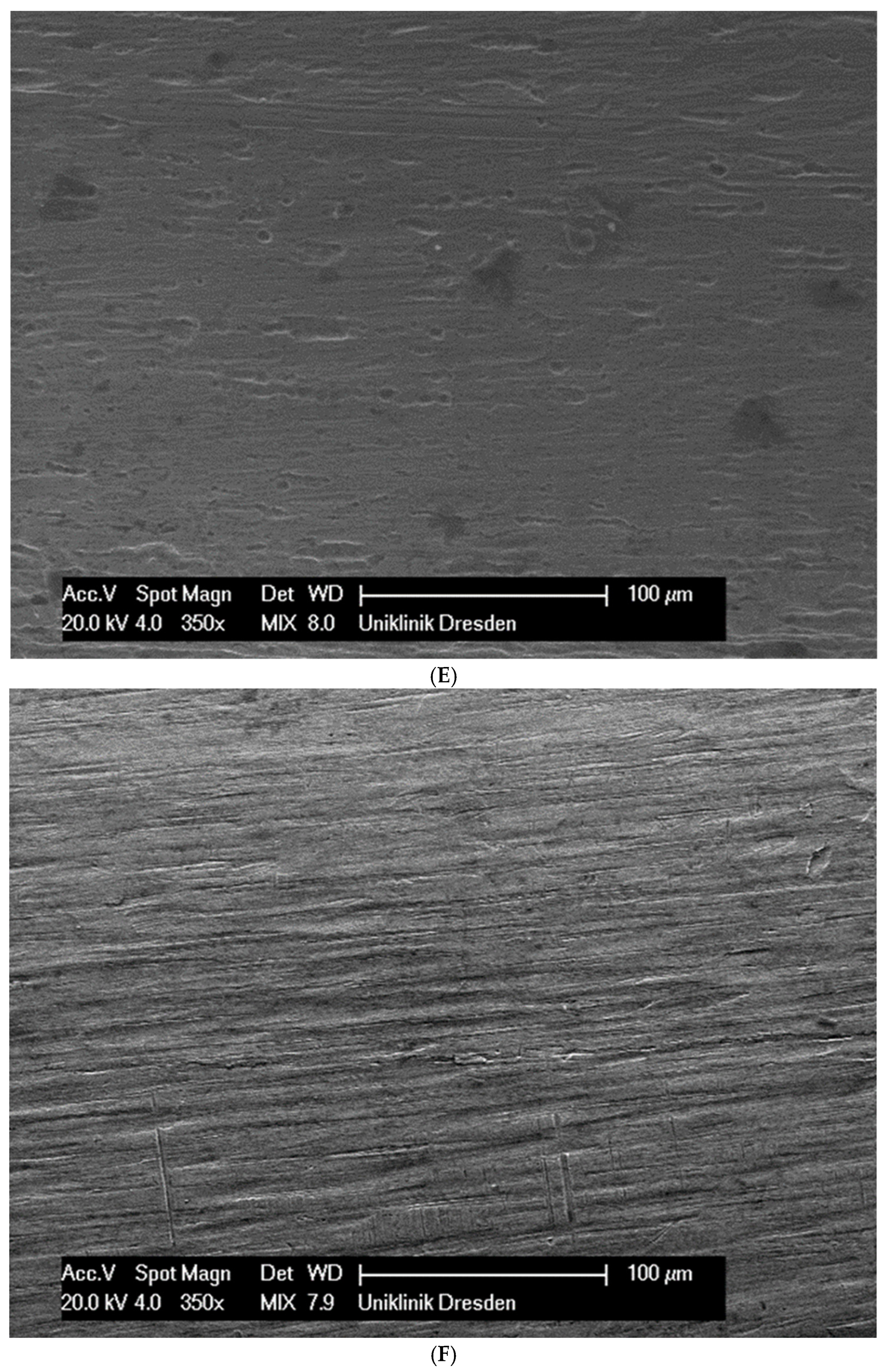
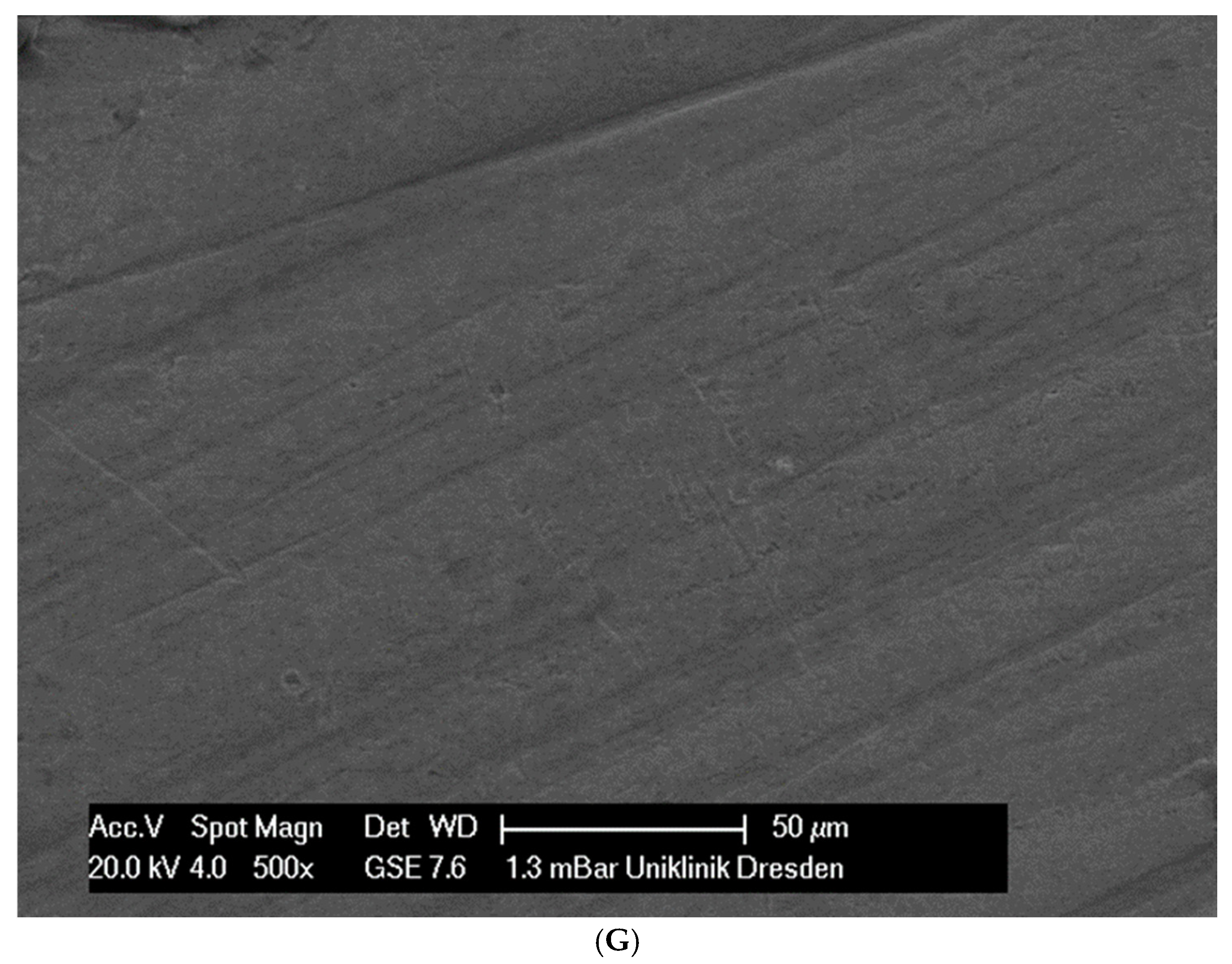
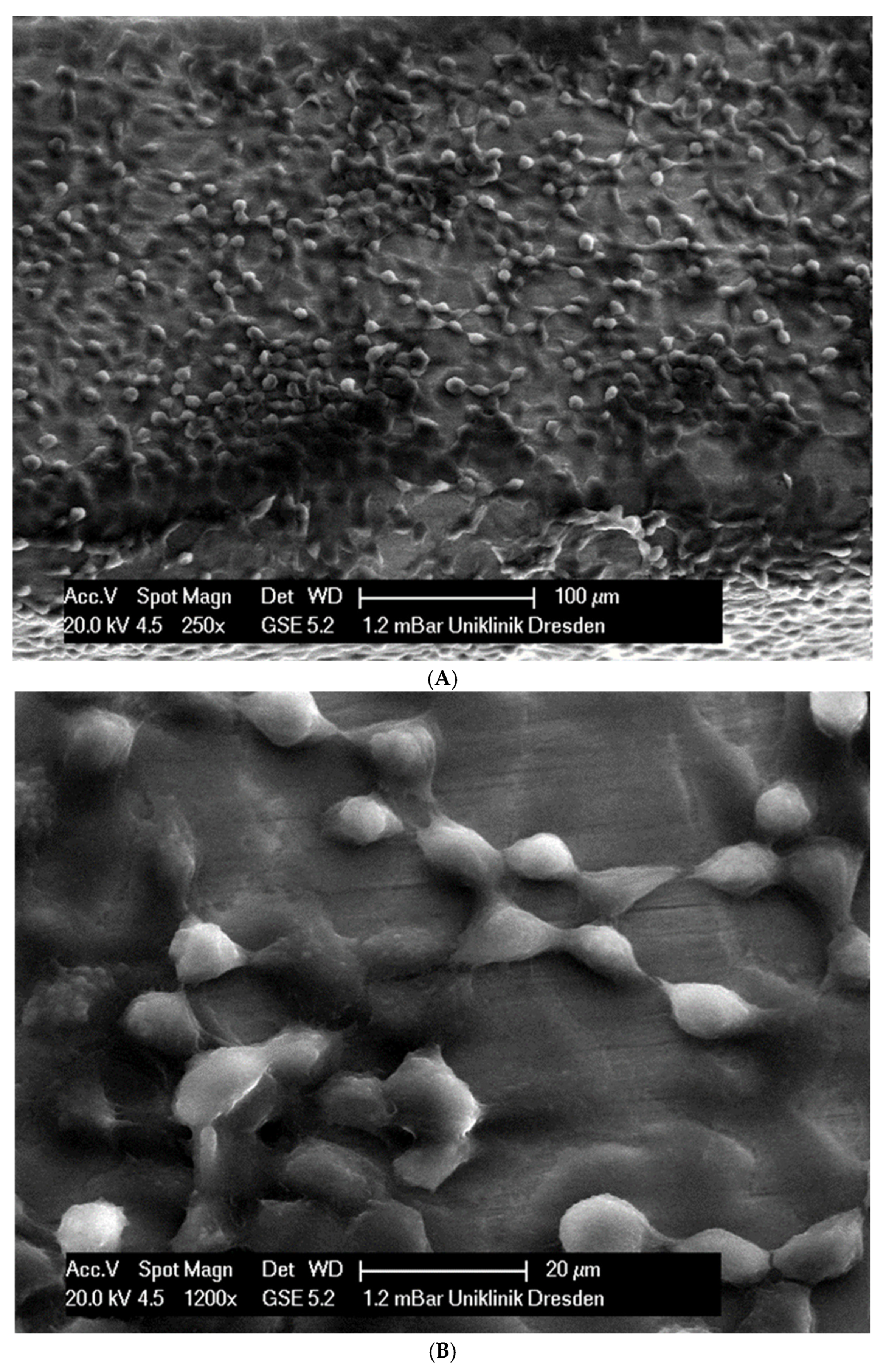

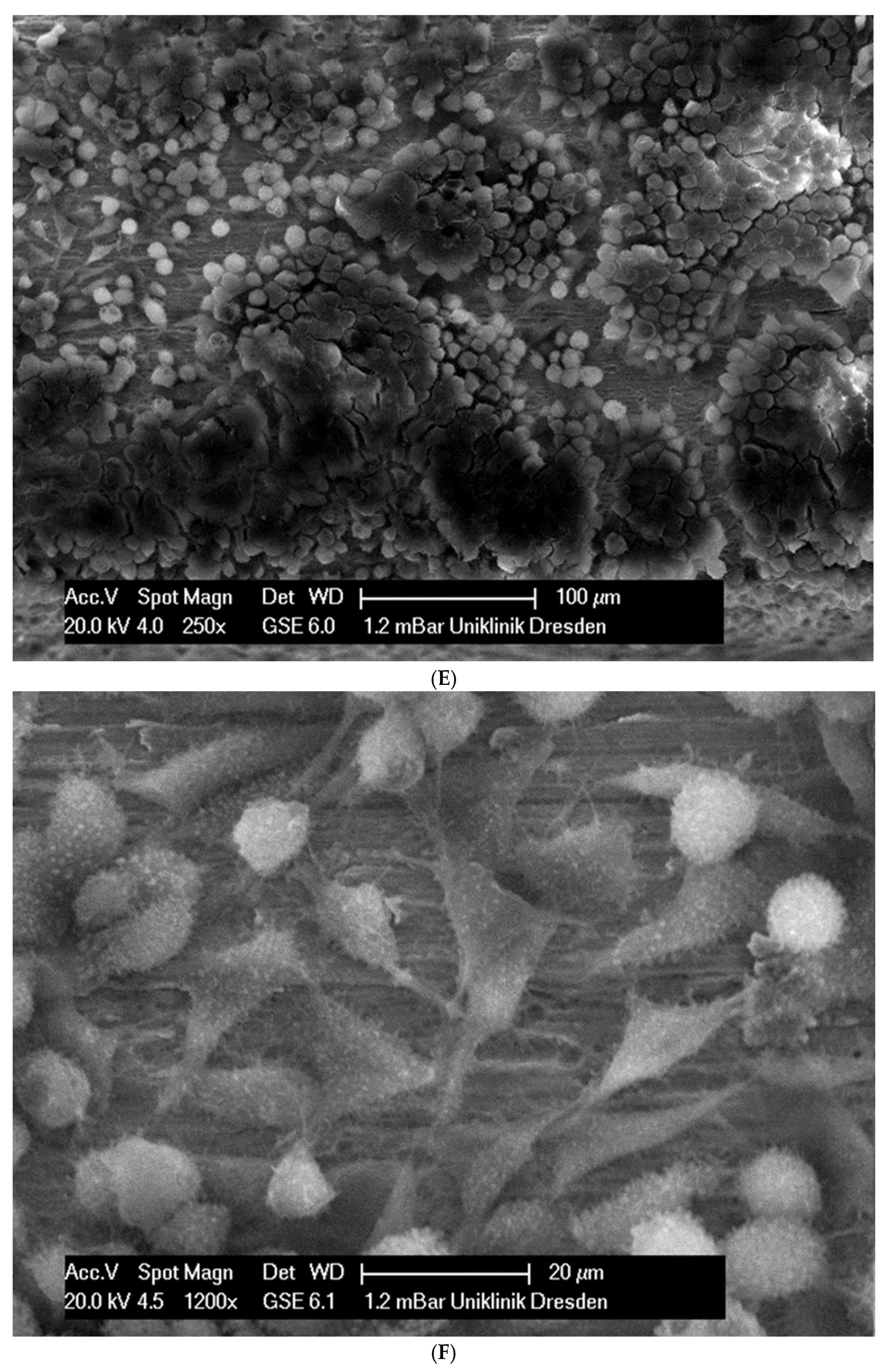
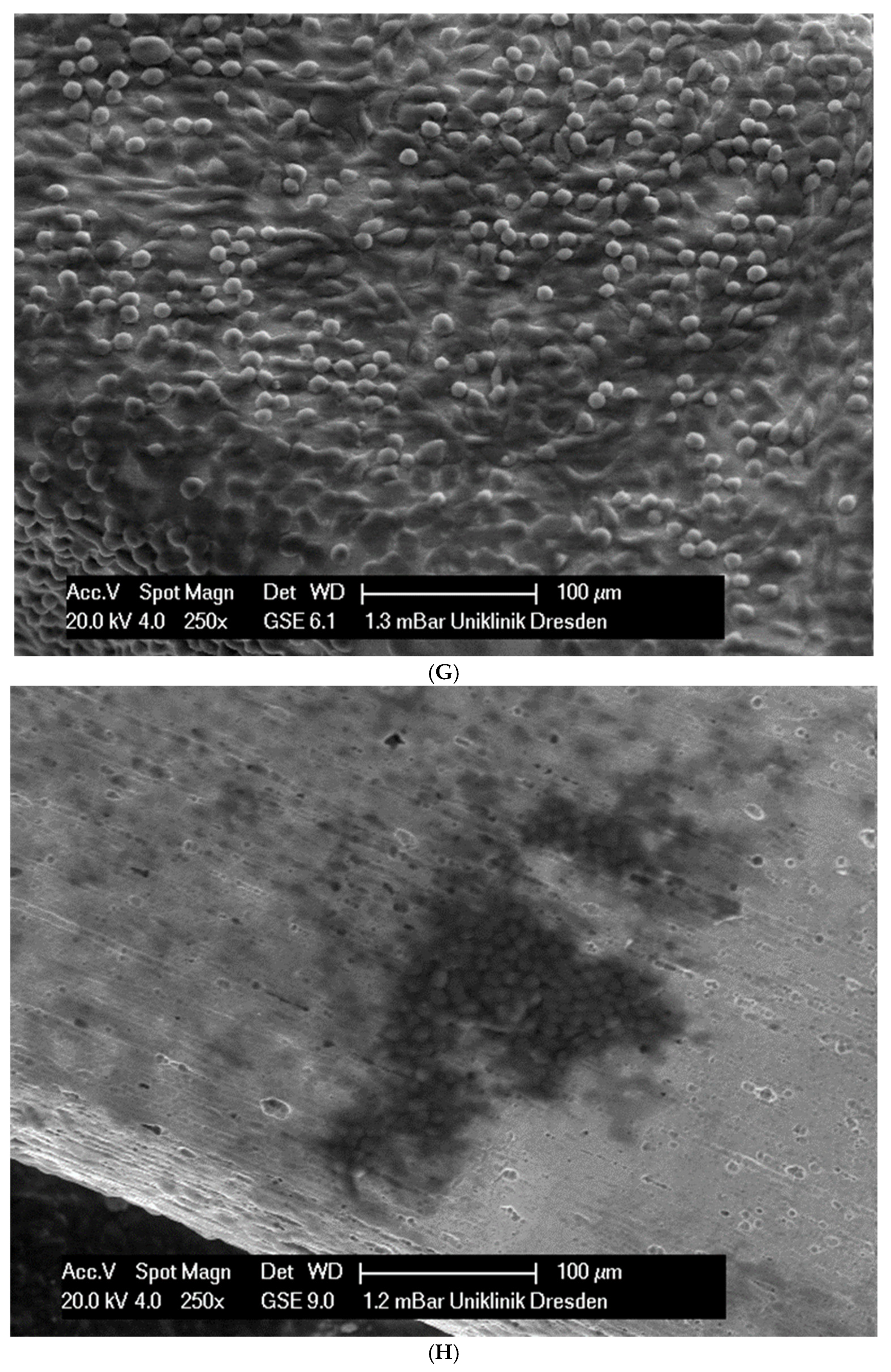
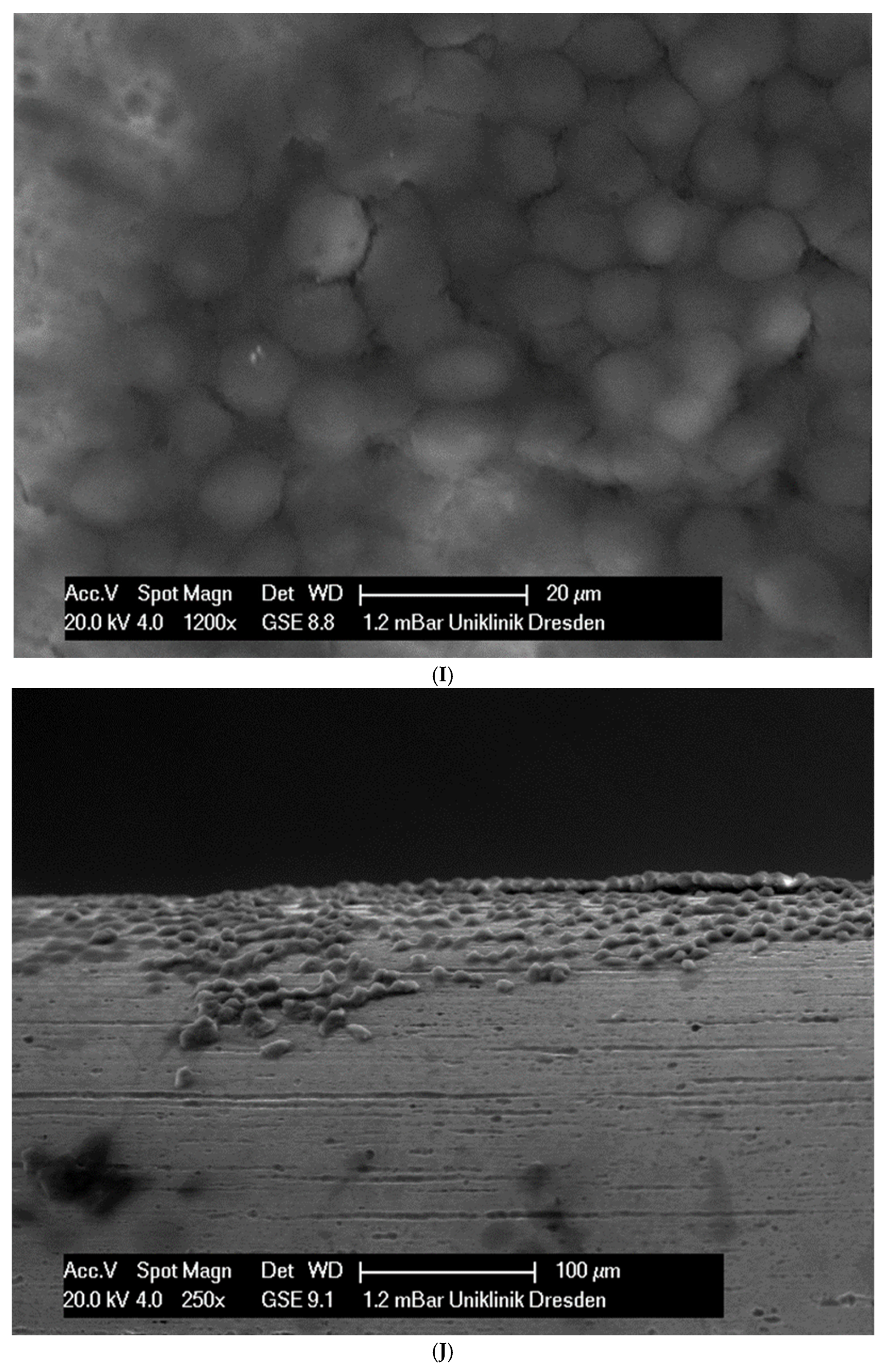
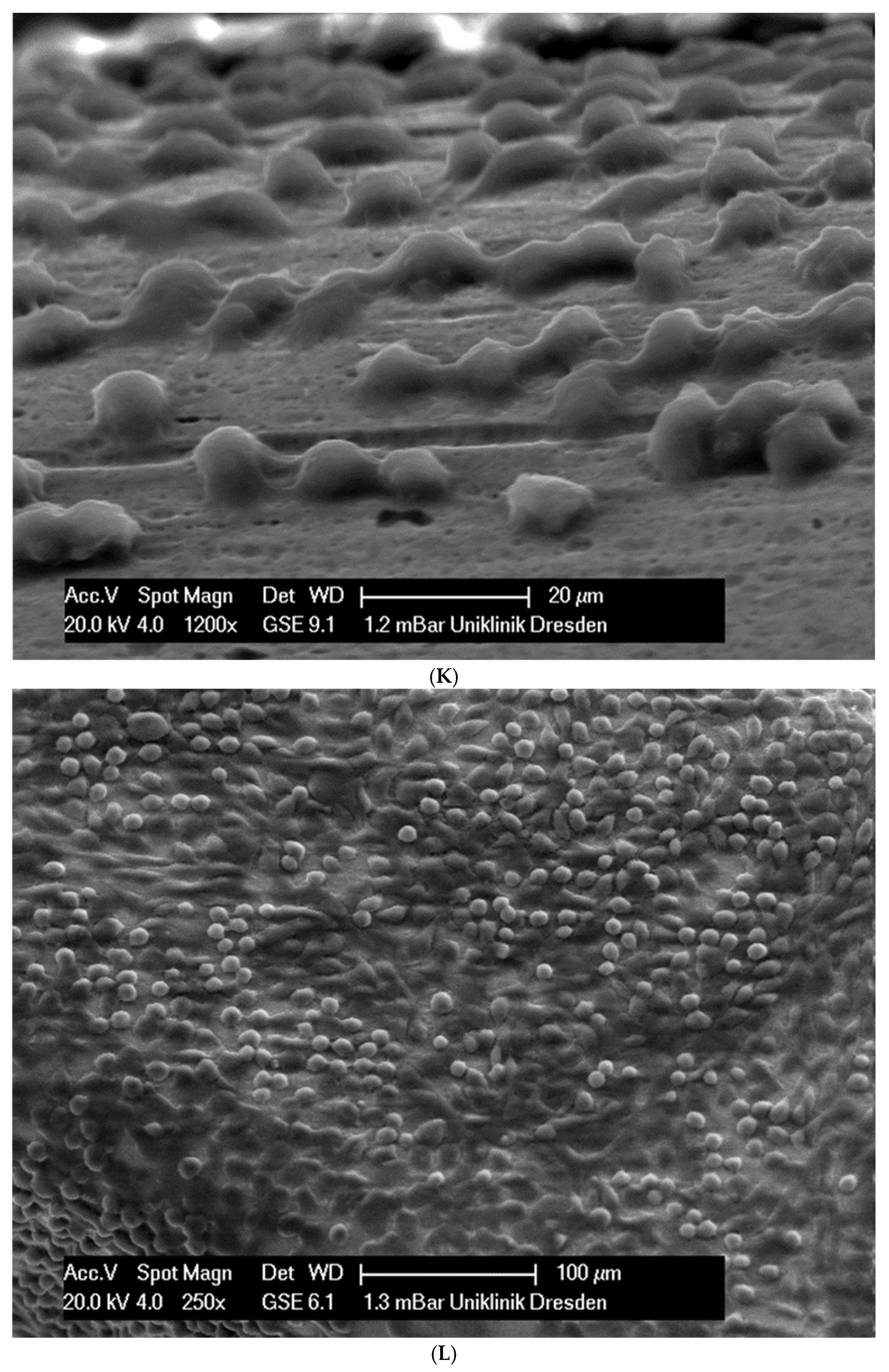
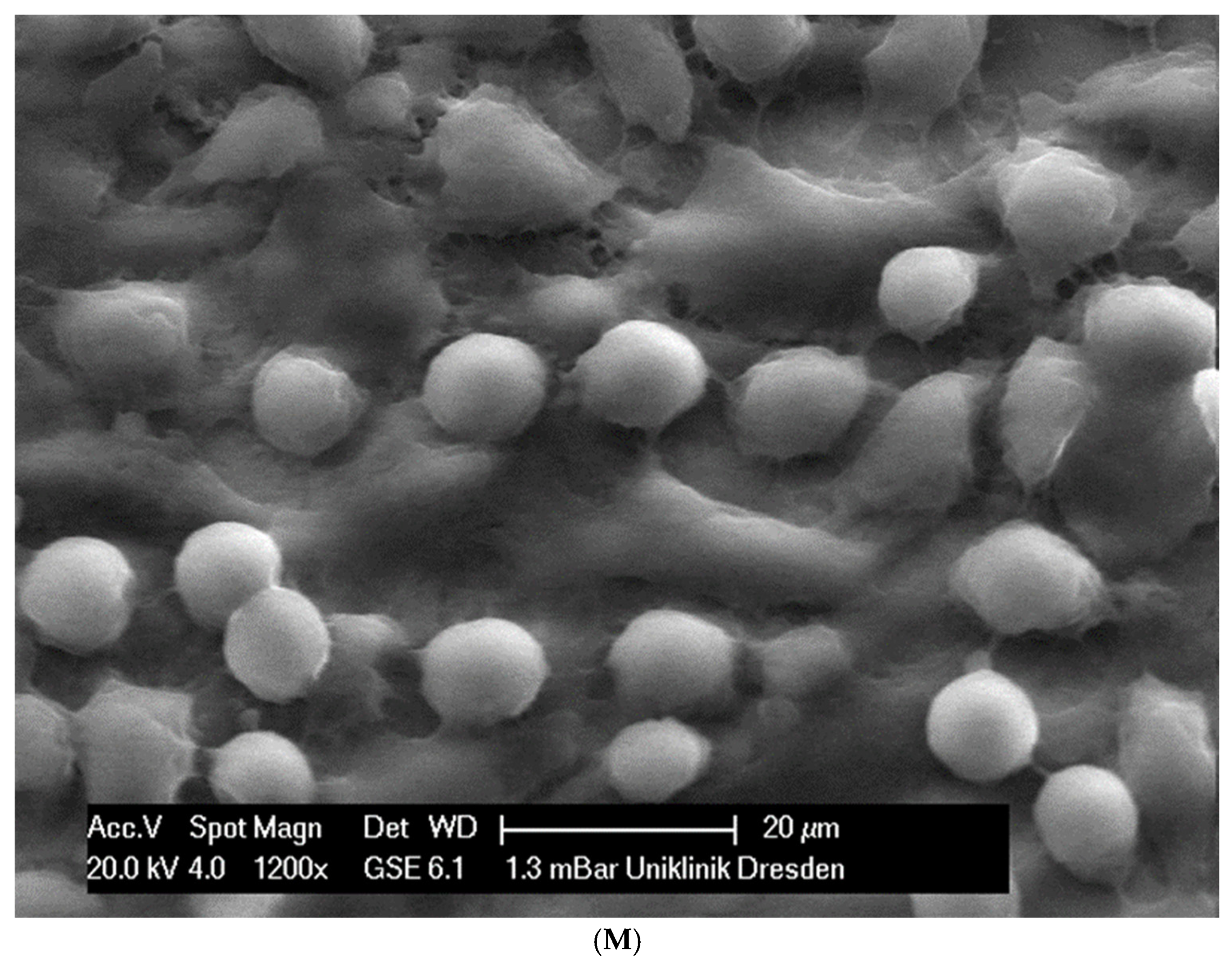


| Archwire | Strength | Elasticity | Bending | Joining | Friction | Biocompatibility |
|---|---|---|---|---|---|---|
| Steel | High | Low | + | + | Lower | +/− |
| Elgiloy | High | Low | + | + | Lower | +/− |
| TMA | Medium | Medium | + | + | Higher | + |
| NiTi | Low | High | − | − | Higher | +/− |
| Type of Alloy | Composition |
|---|---|
| Stainless steel (SS) | 17–20% Cr, 8–12% Ni, 0.15% C balanced with Fe |
| Chromium–cobalt steel (CrCo) Elgiloy | 40% CO, 20% Cr, 15% Ni, 15.8% Fe, 7% Mo, 2% Mn, 0.15% C, 0.04% Be |
| Titanium–molybdenum (TMA) | 77.8% Ti, 11.3% Mo, 6.6% Zr, 4.3% Sn |
| Nickel–titanium (NiTi) | 55% Ni, 45% Ti, (trace amounts Cu) |
Disclaimer/Publisher’s Note: The statements, opinions and data contained in all publications are solely those of the individual author(s) and contributor(s) and not of MDPI and/or the editor(s). MDPI and/or the editor(s) disclaim responsibility for any injury to people or property resulting from any ideas, methods, instructions or products referred to in the content. |
© 2024 by the authors. Licensee MDPI, Basel, Switzerland. This article is an open access article distributed under the terms and conditions of the Creative Commons Attribution (CC BY) license (https://creativecommons.org/licenses/by/4.0/).
Share and Cite
Tokarczuk, O.; Suski, P.; Tokarczuk, B.; Mikulewicz, M. Cytotoxicity of Orthodontic Archwires Used in Clinical Practice: In Vitro Study. Appl. Sci. 2024, 14, 9679. https://doi.org/10.3390/app14219679
Tokarczuk O, Suski P, Tokarczuk B, Mikulewicz M. Cytotoxicity of Orthodontic Archwires Used in Clinical Practice: In Vitro Study. Applied Sciences. 2024; 14(21):9679. https://doi.org/10.3390/app14219679
Chicago/Turabian StyleTokarczuk, Oskar, Piotr Suski, Beata Tokarczuk, and Marcin Mikulewicz. 2024. "Cytotoxicity of Orthodontic Archwires Used in Clinical Practice: In Vitro Study" Applied Sciences 14, no. 21: 9679. https://doi.org/10.3390/app14219679
APA StyleTokarczuk, O., Suski, P., Tokarczuk, B., & Mikulewicz, M. (2024). Cytotoxicity of Orthodontic Archwires Used in Clinical Practice: In Vitro Study. Applied Sciences, 14(21), 9679. https://doi.org/10.3390/app14219679






